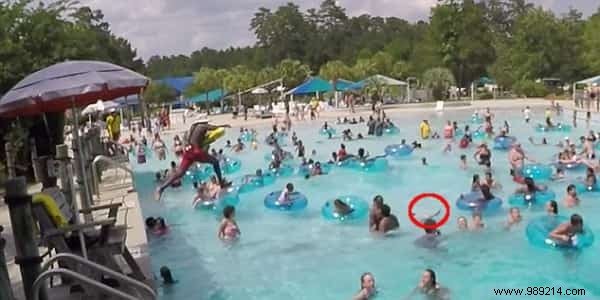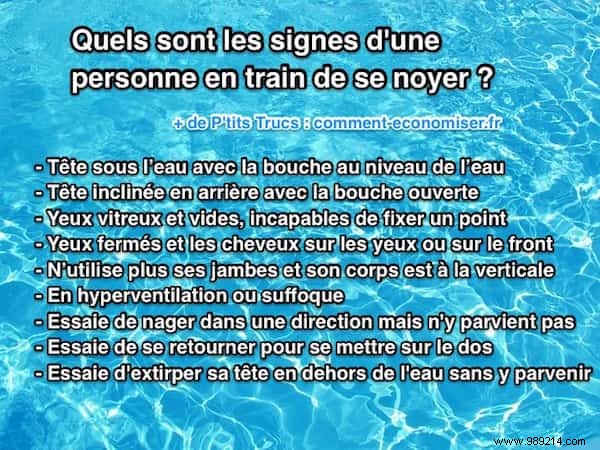
When he sped past Mary's chair, the master -swimmer seemed to appear out of nowhere.
In less time than it takes to tell, he was right in the middle of the group of children who were playing.
Even before Marie was on her 2 feet, the young lifeguard was holding her 10-year-old boy above the surface of the water and bringing him back to the edge of the pool.
Her little man was drowning right before her eyes and Marie had no idea of the drama that was unfolding.

Once out of the water by the lifeguard, the child then ran into his mother's arms.
It was only then that Marie realized the tragedy that had just been averted.
But what did the lifeguard see that this mother failed to see? Drowning is not a violent thing. There are no big splashes or loud squeals as you might expect.
The rescuer was able to recognize the signs of drowning thanks to the experts who trained him and also to his experience. For her part, Marie learned about drowning by watching TV.
If you have to supervise children near water, it is essential that you know how to recognize the signs that should alert you. And this whether there are lifeguards around or not.
As a former lifeguard, stories like Marie's don't surprise me. I hear it constantly. A drowning almost always takes place in silence.
Conditioned by what we see on television, we expect howls, waves, splashes during a drowning. But that's rarely the case in real life. Watch:
The "Instinctive Response to Drowning ", so named by Doctor Francesco A. Pia, is what people do to avoid suffocation in water during drowning.
And I can tell you that it is not at all like what you might think. There are very few splashes, waves, howls or cries for help.
To get a clear idea of just how quiet and unimpressive drowning is, drowning is the 2nd leading cause of accidental death in children under 15 , just after vehicle accidents.
Of the approximately 750 children who will drown next year, approximately 350 of them will be only twenty meters from their parents or another adult.
And in 10% of cases, the parent will even be supervising the child, but without realizing that the drowning is taking place before his eyes.

As you will have understood, a drowning does not ultimately resemble a drowning. Dr. Pia describes the instinctive response to drowning as follows:
1. Except in rare cases, people who drown are physically unable to call for help. The breathing apparatus was designed for breathing. Speech is only a secondary function. The body must first be able to breathe before it can speak.
2. The mouths of drowning people alternately pass below the surface before reappearing above the water. Their mouth does not stay above the surface of the water long enough to exhale, inhale and call for help. The only thing the mouth has time to do when it is above the surface is to inhale and exhale as quickly as possible.
3. People who are drowning cannot wave for help. The survival instinct forces them to extend their arms parallel to the surface of the water in an attempt to lean on them. By pushing on the surface of the water, it allows the person who is drowning to extricate themselves from the water for a moment and have their mouth above the water to breathe.
4. During the Instinctive Drowning Response , drowning people are unable to control the movements of their arms. As a result, people struggling to stay on the surface of the water cannot stop these instinctual movements to wave their hands, turn to a rescuer, or reach out for a lifeline.
5. From beginning to end of Instinctive Drowning Response , the body of drowning people remains upright in the water and there is no indication that the person is struggling with their feet. Unless rescued by a lifeguard, drowning people cannot stay above the surface for more than 20-60 seconds before sinking .

Of course, that doesn't mean that someone who's screaming for help and waving isn't in trouble.
A person with this kind of behavior is surely experiencing what is called vital distress in the aquatic environment .
Not always present before the Instinctive Drowning Response , vital distress in the aquatic environment does not last long.
But unlike drowning, these people still have the ability to pull themselves together. They can still grab a pole, buoy, etc.
So what are the real signs of drowning? Here's what to watch out for when people are in the water:
• The person has their head underwater with their mouth at water level.
• She has her head tilted back with her mouth open.
• Her eyes are glassy and empty, unable to fixate on a point.
• She has her eyes closed and hair over her eyes or on her forehead.
• She no longer uses her legs to swim and her body is vertical.
• She is hyperventilating or suffocating.
• She tries to swim in one direction, but fails.
• She tries to turn over to lie on her back.
• She tries to pull her head out of the water without really succeeding.
So if your kids are playing in the water and everything seems fine, don't be so sure.
Sometimes the best clue that a child is drowning is that they don't actually look like they're drowning . He may just look like he's wading through the water with his eyes up.
So how can you be sure that everything is fine? Just ask him the question:"Are you okay?" ". If the child manages to answer anything, then everything is fine.
But if in answer to your question you get a blank stare, then you have less than 30 seconds to run to him.
Remember:children playing in the water make noise . When it's too quiet, you have to go see what's going on and understand why they are so calm and quiet.